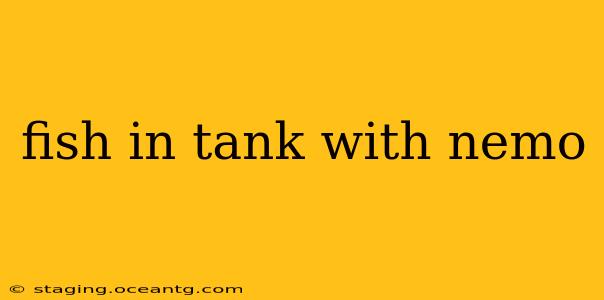The vibrant orange and white stripes of the Ocellaris clownfish, affectionately known as Nemo, make them a captivating centerpiece for any saltwater aquarium. But before you rush to add other fish to their tank, careful consideration is crucial. Introducing incompatible species can lead to stress, aggression, and even death for your beloved Nemo. This guide will explore suitable and unsuitable tank mates for your clownfish, ensuring a thriving and harmonious reef environment.
What Kind of Fish Live with Nemo?
Clownfish, being relatively peaceful and adaptable, can coexist with a variety of carefully selected species. The key is to choose tank mates that are similarly sized, have compatible temperaments, and have similar environmental needs. Remember, even within compatible species, individual personalities can vary. Observing your fish closely is always important.
Some good choices for Nemo's tank mates include:
- Other peaceful, small fish: Certain damselfish, gobies, and cardinalfish can often coexist peacefully with clownfish, provided there's ample space and hiding places. However, research the specific species carefully; some damsels can become aggressive.
- Invertebrates: Many peaceful invertebrates make excellent additions, such as certain shrimps, snails, and crabs. These creatures help maintain tank cleanliness and add visual interest. However, be mindful of larger crabs or shrimps that might pose a threat to smaller fish.
- Similar-sized fish: Avoid introducing significantly larger fish that could see Nemo as prey.
What Fish Should NOT Live with Nemo?
Certain fish should be strictly avoided when keeping Nemo. These include:
- Aggressive fish: Any aggressive or predatory fish will pose a serious threat to clownfish. This includes larger angelfish, triggerfish, and lionfish, to name a few.
- Large fish: Fish considerably larger than Nemo could easily injure or even kill them.
- Fish with similar needs but different personalities: Even within a compatible size and temperament range, if the fish are very territorial, conflicts are bound to occur.
How Many Fish Can Live in a Tank with Nemo?
The number of fish you can safely keep with Nemo depends heavily on the size of your tank. Overstocking leads to stress, poor water quality, and increased risk of disease. A good rule of thumb is to follow the "one-inch-per-gallon" rule, though this is a guideline, not a hard and fast rule. Larger, more active fish will require more space than smaller, less active ones. You also need to account for the space the coral and other decorations will occupy. Always prioritize the well-being of your fish over simply filling the tank.
What Size Tank Do I Need for Nemo and Tank Mates?
A minimum tank size of 20 gallons is generally recommended for a single Ocellaris clownfish. However, for multiple clownfish or the addition of tank mates, a significantly larger tank is necessary, perhaps 55 gallons or more, depending on the size and temperament of the additions. Larger tanks offer more stability in water parameters and provide ample space for all inhabitants to thrive.
What are the Best Tank Mates for a Clownfish?
The "best" tank mates are subjective and depend on your specific tank setup, preferences, and experience level. However, some consistently well-suited choices include certain small gobies (like the Yellow watchman goby), certain peaceful damsels (thorough research is crucial here!), and small, peaceful invertebrates. Research individual species thoroughly before making a decision.
Can I Keep Two Nemo in the Same Tank?
Two Ocellaris clownfish can often coexist, particularly if introduced together. However, they may establish a dominance hierarchy, with one fish becoming more assertive. A larger tank will certainly lessen the likelihood of conflict. It’s important to carefully monitor their interactions and be prepared to separate them if necessary.
By carefully considering tank size, species compatibility, and individual fish personalities, you can create a thriving and visually appealing reef environment where your Nemo and their tank mates can flourish. Remember to always prioritize the health and well-being of your fish and research extensively before introducing any new inhabitants to your aquarium.
